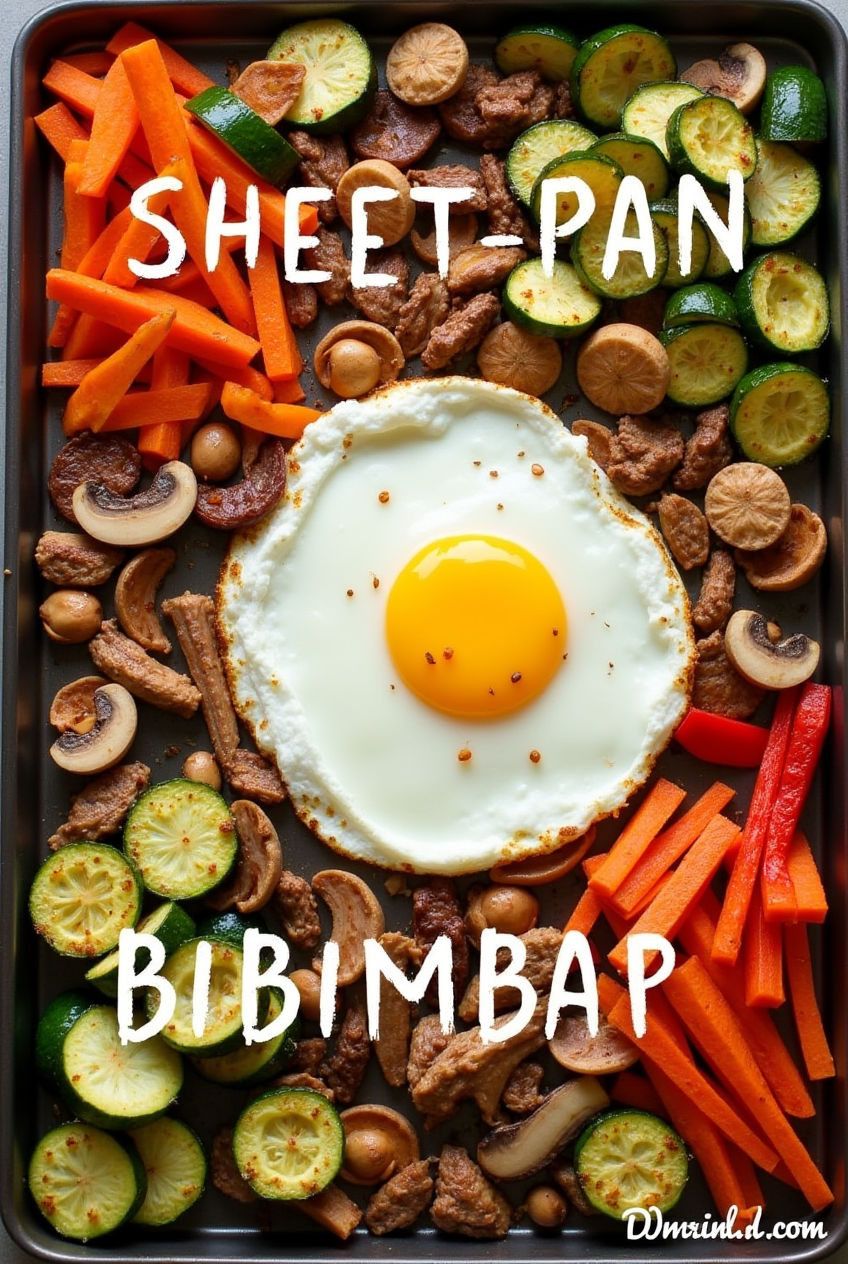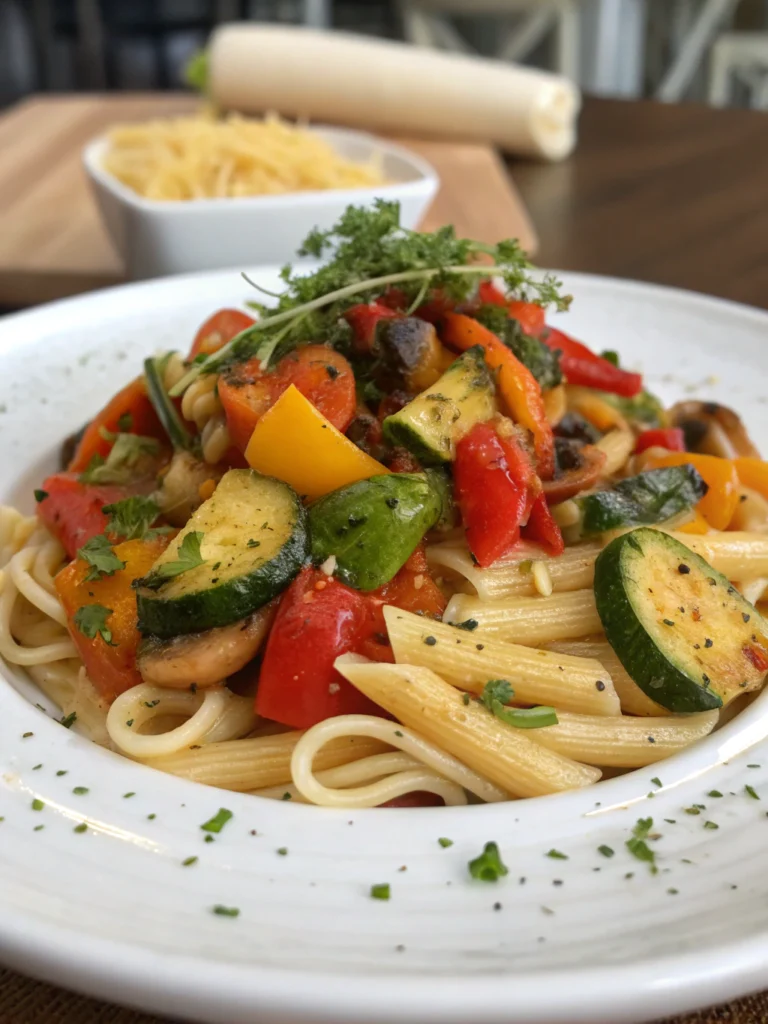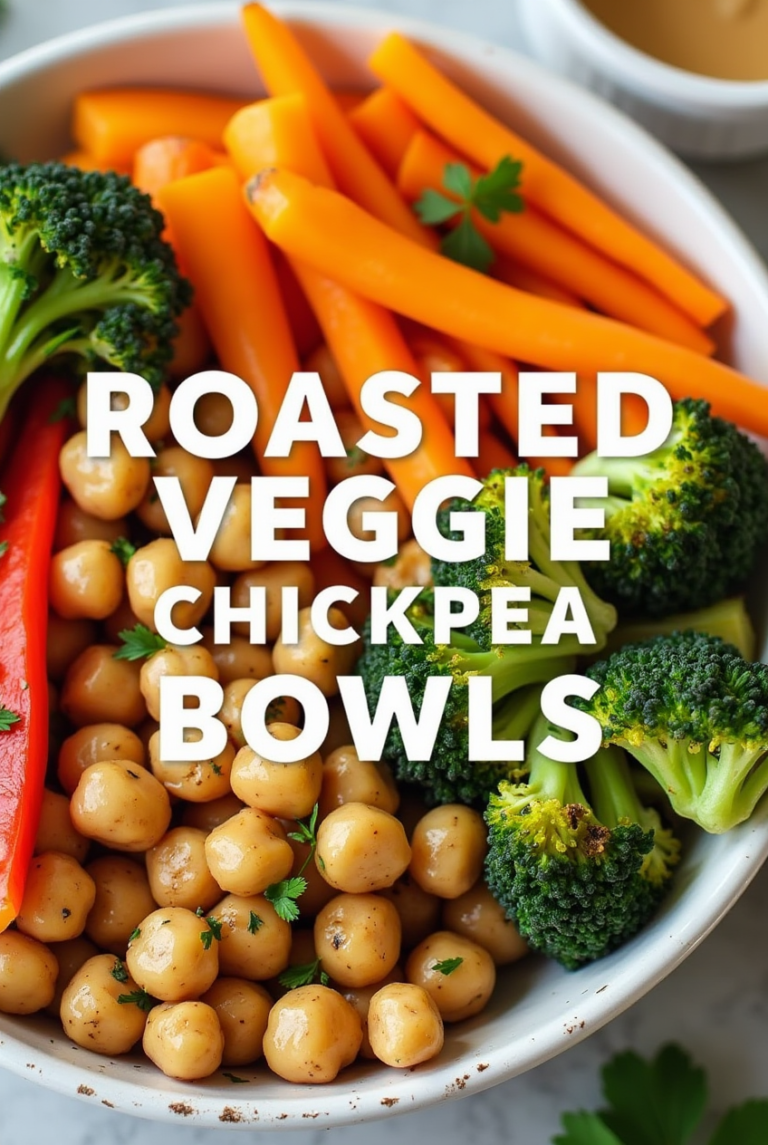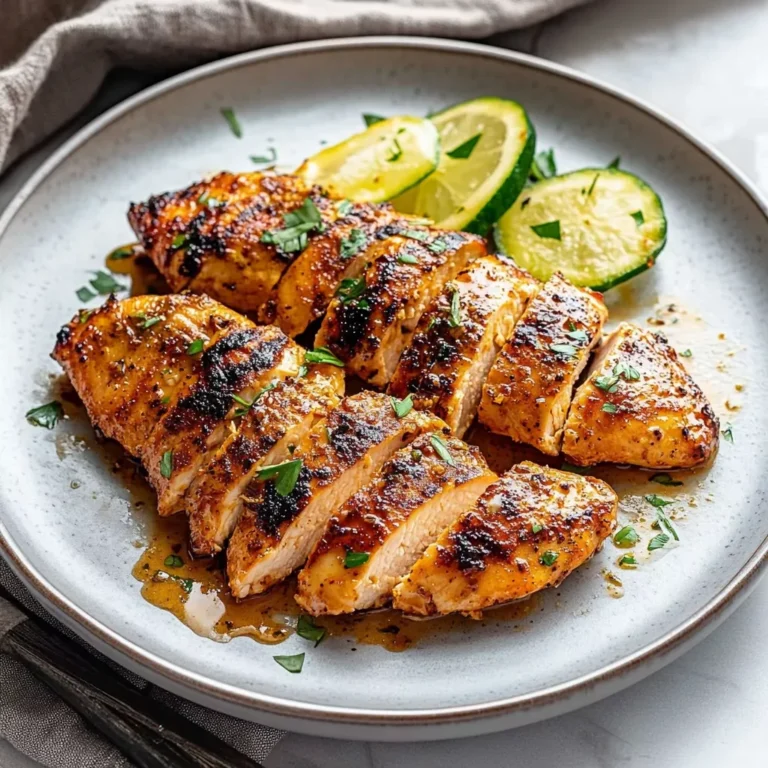Sheet-Pan Bibimbap – A Flavorful One-Pan Korean-Inspired Delight
Looking for a meal that’s colorful, healthy, bold in flavor, and super easy to clean up after? Say hello to Sheet-Pan Bibimbap – your new go-to for a wholesome, quick, and delicious dinner. This Korean-inspired twist on the traditional Bibimbap takes everything we love about the classic bowl and simplifies it into a one-pan wonder that fits perfectly into busy weeknights or lazy weekend meals. Trust me, once you try this, you’ll be craving it on repeat.
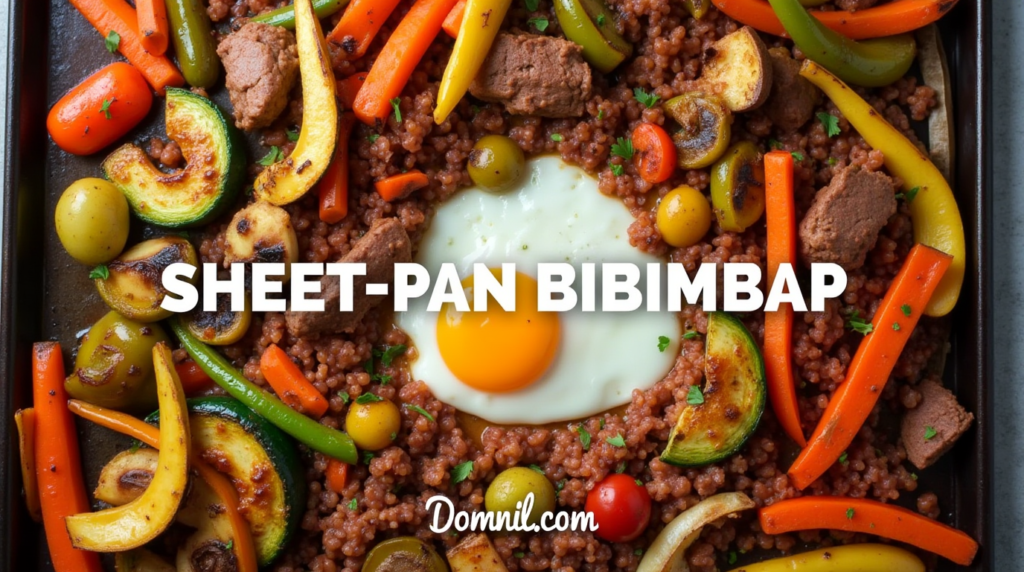
Table of Contents
Introduction to Sheet-Pan Bibimbap
What is Bibimbap?
Bibimbap is one of Korea’s most beloved comfort foods – a vibrant bowl loaded with rice, a medley of sautéed or roasted vegetables, protein (often beef, tofu, or egg), and topped off with a dollop of spicy-sweet gochujang sauce. The word “bibimbap” literally translates to “mixed rice,” and that’s the whole point: all the ingredients are beautifully arranged in the bowl, and then right before eating, you mix everything up. It’s a celebration of flavor, texture, and nutrition in every bite.
The dish is traditionally served in a hot stone bowl called “dolsot,” which crisps up the bottom layer of rice for a delightful crunch. But since not everyone has access to a dolsot at home, especially on a busy night, this sheet-pan method gives you all the joy without the extra hassle. You still get the caramelized edges and depth of flavor, just without the stovetop juggling.
Why Make it Sheet-Pan Style?
Simple – it’s convenient, fast, and way less messy. Instead of cooking each component separately, the sheet-pan approach allows you to roast everything – vegetables, protein, even tofu – all on one tray. That means less cleanup and more time to enjoy your food. It also ensures even roasting, unlocking the natural sweetness of veggies and creating deliciously crispy textures.
Another major plus? It’s highly customizable. Got some leftover veggies in the fridge? Toss them on the pan. Prefer tofu over beef? No problem. This is a dish that bends to your tastes and whatever ingredients you’ve got on hand.
Ingredients You’ll Need
Core Ingredients
To make an irresistible sheet-pan bibimbap, you’ll need a few basic ingredients that form the heart of the dish. These essentials include:
- Short-grain white rice or jasmine rice – cooked and fluffy
- Carrots – julienned or thinly sliced
- Zucchini – sliced into half-moons
- Mushrooms – shiitake or button, sliced
- Bell peppers – any color, for that rainbow effect
- Protein – beef bulgogi, tofu, chicken, or even tempeh
- Gochujang – Korean chili paste that’s tangy, spicy, and slightly sweet
- Soy sauce – for that umami boost
- Sesame oil – nutty and fragrant
- Garlic – minced or grated
- Scallions – thinly sliced, for garnish
- Eggs – fried and runny (or poached if you prefer)
These are the non-negotiables to get that authentic bibimbap flavor, even when using the oven instead of a stovetop. The key here is balance – you want a mix of colors, textures, and flavors.
Optional Add-ins for Extra Flavor
Feeling a little adventurous? There are tons of ways to elevate your sheet-pan bibimbap:
- Kimchi – adds a fermented tang and a spicy kick
- Spinach or kale – roasted or lightly sautéed
- Corn kernels – for a touch of sweetness
- Radishes – sliced thin for a crunchy bite
- Bean sprouts – roasted or raw
- Nori strips – for a briny, umami finish
- Pickled cucumbers – for some zing
- Toasted sesame seeds – sprinkled on top for texture
The beauty of this dish is that you can tailor it to your taste, dietary needs, or what’s currently in your fridge. It’s incredibly flexible and forgiving, so don’t stress too much about exact ingredients.
Choosing the Right Proteins
Traditional Korean Proteins
The most classic protein used in bibimbap is bulgogi – thinly sliced beef marinated in a sweet-savory sauce made from soy sauce, sugar, garlic, and sesame oil. Bulgogi is tender, flavorful, and cooks beautifully on a sheet pan. Chicken or pork marinated in a similar sauce also works wonders.
If you’re sticking with traditional flavors but want to switch up the protein, consider these:
- Ground beef or turkey with Korean seasoning
- Sliced Korean BBQ pork
- Grilled shrimp with gochujang glaze
Marination is key. Let the meat soak up those flavors for at least 30 minutes before roasting for the best taste.
Plant-Based Alternatives
For vegetarians and vegans, there’s no shortage of options:
- Tofu – firm or extra-firm, pressed and cubed, then marinated or tossed in soy sauce and sesame oil
- Tempeh – nutty and firm, perfect for absorbing bold flavors
- Seitan – great for mimicking the texture of meat
- Roasted chickpeas – for a bit of crunch and protein
Pan-roasting tofu and tempeh gives them crispy edges and a satisfying chew that contrasts nicely with the softer veggies and rice. Don’t forget to season them well – the more flavorful the protein, the more satisfying your bibimbap will be.
Picking the Perfect Vegetables
Best Vegetables for Sheet-Pan Cooking
The secret to great sheet-pan bibimbap is variety – in color, texture, and taste. Here are the MVPs that roast like a dream:
- Carrots – sweet, slightly caramelized when roasted
- Zucchini – soft, juicy, and quick to cook
- Mushrooms – earthy and umami-rich
- Bell Peppers – colorful and slightly charred on the edges
- Onions – caramelized and sweet when roasted
- Sweet potatoes – if you want a hearty twist
These veggies cook well together in about 25–30 minutes at 400°F (200°C). Make sure to spread them out evenly to avoid steaming and ensure browning.
Seasonal Vegetable Variations
Want to make this dish year-round? Here are some seasonal veggie swaps:
- Spring: Asparagus, green peas, radishes
- Summer: Corn, cherry tomatoes, eggplant
- Fall: Butternut squash, Brussels sprouts
- Winter: Cabbage, parsnips, beets
Adjust roasting times as needed, but the beauty of this method is that once you get the hang of it, you can mix and match endlessly based on what’s fresh and local.
The Magic of Gochujang Sauce
What is Gochujang?
Gochujang is the heart and soul of bibimbap. This thick, red chili paste is a staple in Korean cuisine. It’s got a unique flavor profile – spicy, slightly sweet, salty, and umami-rich. Made from fermented soybeans, red chili powder, rice, and salt, it adds depth and a slow-burning heat that’s addictively good.
Unlike other hot sauces, gochujang has body – it clings to your food and becomes part of the dish, not just a topping. It’s the difference between flavor and fire, and sheet-pan bibimbap just wouldn’t be the same without it.
Homemade vs. Store-Bought Sauce
You can absolutely buy gochujang at any Asian grocery store or online. But if you want to go the extra mile, you can mix up a homemade sauce using:
- 2 tbsp gochujang
- 1 tbsp sesame oil
- 1 tbsp soy sauce
- 1 tsp rice vinegar
- 1 tsp honey or maple syrup
- 1 garlic clove, minced
Stir until smooth and drizzle it over your final bowl. You’ll get that punchy, tangy-sweet heat that pulls everything together beautifully.
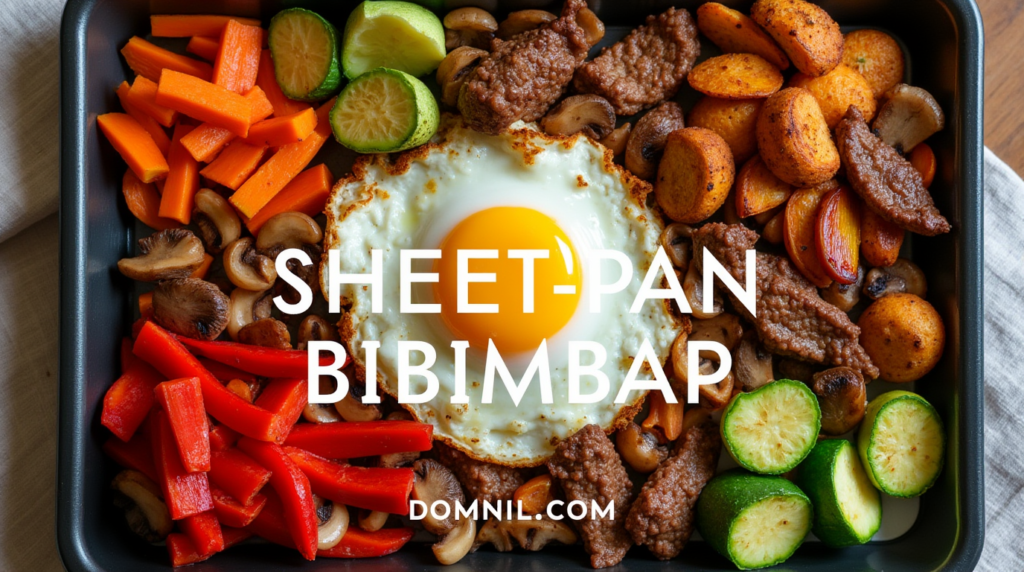
Step-by-Step Cooking Instructions: Sheet-Pan Bibimbap
Prepping Ingredients for Even Roasting
The first step to sheet-pan bibimbap success? Prepping your ingredients like a pro. The goal here is to make sure everything cooks evenly and achieves maximum caramelization without getting soggy or burnt. Here’s how:
- Cut uniformly – Whether you’re slicing carrots, zucchini, or mushrooms, aim for similar sizes. This helps ensure they roast at the same rate.
- Dry your veggies – Moisture is the enemy of roasting. Pat your veggies dry after washing them to avoid steaming.
- Use separate bowls for seasoning – Toss each type of vegetable in its own bowl with a light coating of sesame oil, soy sauce, and garlic. This allows you to season to taste and prevent over-oiling.
- Layer smartly – Place heartier veggies (like carrots and sweet potatoes) on one side of the pan and quick-cooking ones (like zucchini or mushrooms) on the other. This lets you remove quicker-cooking items early if needed.
For proteins, whether you’re using tofu or marinated beef, let them come to room temperature before roasting. This helps them cook evenly and sear better in the oven.
Sheet-Pan Cooking Timeline
Set your oven to 400°F (200°C) and line a large sheet pan with parchment paper or foil for easy cleanup. Here’s a foolproof step-by-step guide:
- Step 1: Roast the Veggies
Place your seasoned vegetables on the sheet pan in a single layer. Roast for 15 minutes, flipping halfway through for even browning. - Step 2: Add Protein
Once the veggies are starting to soften, add your marinated protein (tofu, beef, tempeh) to the pan. Roast everything together for another 15 minutes, flipping the protein once during the process. - Step 3: Fry the Eggs Separately
While the veggies and protein are roasting, fry your eggs in a non-stick pan. Go sunny-side-up for that glorious runny yolk or fully cook it if you prefer. - Step 4: Assemble Your Bowl
Scoop cooked rice into bowls, top with roasted veggies and protein, add a fried egg, and drizzle with gochujang sauce. - Optional Step: Broil for Crispiness
Want extra char and crisp edges? Broil the whole tray for 2-3 minutes at the end – just keep an eye on it!
Building the Perfect Bowl
How to Assemble Like a Pro
Assembling your bowl is all about presentation, balance, and flavor layering. The traditional bibimbap look is a colorful, organized layout where each ingredient shines on its own before you mix them up. Here’s how to do it justice:
- Start with a warm rice base – Spread a generous layer of steamed rice at the bottom of your bowl.
- Add vegetables in sections – Arrange each roasted veggie in its own “wedge” like a pie chart. This looks stunning and lets diners see all the different components.
- Top with your protein – Center your protein over the rice or place it in its own section if you’re serving multiple proteins.
- Place the egg on top – Right in the center is ideal. That golden yolk will ooze beautifully once broken.
- Drizzle with gochujang sauce – Over the top or in a small ramekin on the side.
- Finish with garnishes – Think sliced scallions, toasted sesame seeds, shredded nori, or a squeeze of lime.
This kind of visual feast makes eating even more enjoyable. It’s colorful, vibrant, and Instagram-worthy every time.
Tips for Picture-Perfect Presentation
- Use a wide, shallow bowl – More surface area = better presentation.
- Don’t overcrowd – Keep each element in its own little section.
- Play with color – Use red peppers, orange carrots, green zucchini, and purple cabbage for a rainbow effect.
- Clean edges – Wipe the rim of the bowl before serving for a professional finish.
- Garnish last – Add a pop of green or crunch right before serving for freshness.
Taking the time to plate your bibimbap beautifully can transform a simple weeknight meal into a restaurant-quality experience.
The Role of the Fried Egg
Egg Doneness Levels
That golden fried egg with a luscious, runny yolk is practically the crown jewel of bibimbap. It’s not just for show—it adds richness, silkiness, and acts like a natural sauce when mixed into the rice. But not everyone likes their egg the same way, so here’s how to cater to all preferences:
- Sunny-Side-Up: The yolk stays runny, the whites are set. Most classic choice.
- Over-Easy: A gentle flip gives you a barely set yolk, slightly less runny.
- Over-Medium: Yolks start to firm up, but still a little soft inside.
- Over-Hard: Fully cooked yolks – great for those who don’t like runny eggs.
- Poached: Fancy, elegant, and soft – a great alternative to frying.
- Scrambled or Omelet-style: For kids or picky eaters.
A runny yolk is great for mixing, but if you’re meal-prepping or packing leftovers, a firmer egg might hold up better.
Vegan Alternatives to the Egg
Going egg-free? No problem. These vegan egg alternatives still bring flavor, texture, and that finishing touch:
- Pan-fried tofu slices – lightly crispy on the outside, soft inside
- Avocado slices – creamy and rich, with healthy fats
- Cashew cream or tahini drizzle – adds richness without dairy or egg
- Vegan egg replacers – like JUST Egg, which fries up like the real thing
Or skip the “egg” altogether and let the sauce do the talking. Sheet-pan bibimbap is adaptable enough to fit any lifestyle or dietary preference.
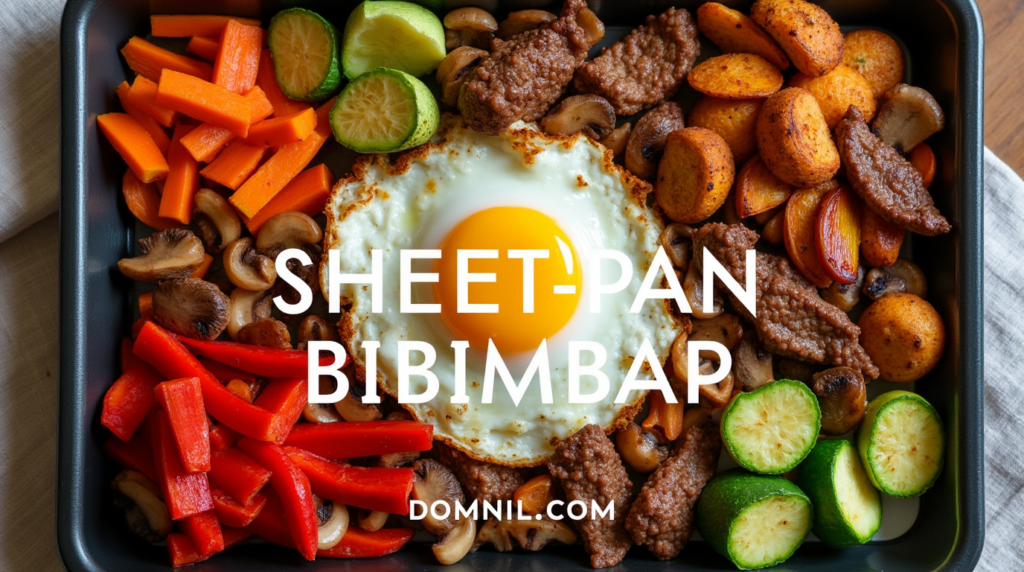
How to Serve and Enjoy
Plating Tips
When it’s time to serve, don’t just toss everything in a bowl (unless that’s your style, of course!). Plating your bibimbap thoughtfully adds to the enjoyment:
- Use wide, shallow bowls or deep plates to showcase all the components.
- Keep ingredients separated for that signature bibimbap look.
- Always top with your egg and sauce last.
- Garnish thoughtfully – scallions, sesame seeds, and a splash of sesame oil can do wonders.
A beautiful presentation isn’t just for the ‘gram—it’s a way to show appreciation for the meal and the effort that went into it.
Best Sides and Accompaniments
Want to turn your sheet-pan bibimbap into a full Korean feast? Add these traditional (and modern) side dishes:
- Kimchi – Fermented spicy cabbage or radish
- Pickled daikon or cucumbers – Adds a fresh, tangy crunch
- Seaweed salad – Light and refreshing
- Miso soup – Not Korean, but a gentle palate cleanser
- Korean pancakes (pajeon) – Crispy, savory veggie pancakes
Even a simple cup of green tea or a cold glass of makgeolli (Korean rice wine) can elevate the meal.
Sheet-Pan Bibimbap for Meal Prep
Storage Tips
Sheet-pan bibimbap is the kind of dish that works beautifully for meal prep. Roast a big batch on Sunday and enjoy vibrant, nourishing meals all week long. To keep everything fresh:
- Store components separately – Keep rice, veggies, protein, and sauce in individual containers. Eggs are best made fresh.
- Use airtight containers – Prevents drying out and retains flavors.
- Cool before storing – Avoid condensation and sogginess.
Properly stored, components will last 3–4 days in the fridge. You can even freeze the rice and protein separately for longer storage.
Reheating without Losing Flavor
When it’s time to reheat, skip the microwave if you can. Here’s how to bring those flavors back to life:
- Rice: Sprinkle a little water over rice and reheat in the microwave covered, or steam on the stovetop for a fluffier texture.
- Veggies and protein: Pop into a hot oven (375°F) for 10 minutes or quickly sauté them in a pan to re-crisp.
- Egg: Fry or poach a fresh one – it only takes a couple of minutes and makes a big difference.
Meal prepping this dish doesn’t mean sacrificing flavor or texture. With the right storage and reheating techniques, every bite can feel like the first time.
Customizing to Your Taste
Spice Level Adjustments
Bibimbap is known for its spicy kick, thanks to the beloved gochujang sauce. But not everyone enjoys a tongue-tingling burn, and that’s perfectly okay. The beauty of sheet-pan bibimbap is that it’s incredibly easy to adjust the spice level to suit your preferences or those of your guests. Here’s how:
- Mild: Use just a small dab of gochujang or mix it with more sesame oil and a touch of honey or maple syrup to mellow out the heat.
- Medium: Stick with the standard sauce mixture but balance it with sweet notes from sugar or mirin.
- Spicy: Add sriracha, chili flakes, or even a pinch of Korean chili powder (gochugaru) to the gochujang mix for extra fire.
- Fire-breathing dragon: Go all-in with a full tablespoon of gochujang per bowl and a hit of raw garlic or diced chili peppers on top.
You can even make two versions of the sauce—one mild, one hot—and let diners choose their adventure. It’s an easy way to cater to spice lovers and spice-avoiders alike.
Diet-Friendly Tweaks (Keto, Vegan, GF)
No matter your dietary restrictions, there’s a version of sheet-pan bibimbap that can work for you:
- Keto/Low-Carb: Swap the rice for cauliflower rice or shredded cabbage. Use avocado, eggs, and grilled meats or tofu for fat and protein.
- Vegan: Stick with tofu or tempeh, skip the egg or use vegan substitutes, and make sure your gochujang is vegan (some contain honey or anchovy).
- Gluten-Free: Use tamari instead of soy sauce, and double-check that your gochujang is certified gluten-free.
Bibimbap is naturally veggie-heavy, making it a great starting point for any health-conscious eater. You don’t have to sacrifice flavor to stick to your goals—just make a few smart swaps.
Health Benefits of Bibimbap Ingredients
Nutritional Highlights
Sheet-pan bibimbap isn’t just about bold flavor—it’s also a nutritional powerhouse. Every element on your tray brings something valuable to the table:
- Vegetables: Packed with vitamins A and C, fiber, antioxidants, and natural sugars that caramelize beautifully during roasting.
- Whole grains (if using brown rice or quinoa): Offer more fiber and nutrients than white rice.
- Eggs and tofu: High in protein and essential amino acids.
- Gochujang: Contains probiotics from the fermentation process, promoting gut health.
- Sesame oil: Rich in heart-healthy fats and antioxidants.
This isn’t a cheat meal—it’s a well-balanced, complete meal that hits all the major food groups. Plus, you’re in control of the oil, salt, and sugar content, which means it’s easier to eat clean without compromising taste.
Balanced Meal Benefits
With its combination of lean protein, slow-digesting carbs, healthy fats, and fiber-rich veggies, bibimbap is the kind of dish that leaves you satisfied—not stuffed or sluggish. Here are a few more benefits:
- Steady energy release thanks to the balance of macros.
- Great for digestion with all the fiber and fermented components like kimchi.
- Ideal for weight management, as it’s filling without being calorie-dense.
- Customizable for allergies or food sensitivities.
Eating well doesn’t have to mean plain salads or boring chicken breasts. Bibimbap proves that healthy can also mean fun, flavorful, and crave-worthy.
Sheet-Pan Bibimbap Around the World
Global Variations of Bibimbap
Bibimbap may have originated in Korea, but its concept has inspired culinary mashups all around the globe. Chefs and home cooks alike have embraced the idea of mixing rice, veggies, and sauce to create international spins on the classic:
- Japanese-Inspired: Swap gochujang for teriyaki sauce, add pickled ginger and edamame.
- Mexican Bibimbap: Use cilantro-lime rice, black beans, grilled corn, and a spicy chipotle sauce.
- Mediterranean Twist: Include roasted eggplant, chickpeas, tzatziki, and hummus.
- Indian Fusion: Add spiced cauliflower, turmeric rice, and a yogurt-based sauce like raita.
These spins maintain the core bibimbap structure—rice, veggies, protein, sauce—but add regional flair. It’s proof that the format is endlessly adaptable and universally loved.
Fusion Cuisine and Creative Twists
You don’t have to stick strictly to Korean ingredients to enjoy the bibimbap experience. Fusion bowls are a fun and creative way to keep the meal exciting:
- Breakfast Bibimbap: With roasted sweet potatoes, spinach, avocado, a fried egg, and sriracha.
- BBQ Bibimbap: Pulled pork, coleslaw-style cabbage, grilled corn, and smoky BBQ sauce.
- Seafood Bibimbap: Add roasted shrimp, scallops, or salmon with a citrusy sauce.
The possibilities are endless—and a great way to experiment with whatever ingredients you’ve got in your fridge. Think of sheet-pan bibimbap as a canvas for your culinary creativity.
Common Mistakes to Avoid
Overcooking or Undercooking Veggies
Roasting veggies sounds easy enough, but getting the texture just right can be tricky. Overcooked vegetables become mushy, while undercooked ones are too firm or raw in the middle. Here’s how to avoid both:
- Cut everything uniformly so they roast at the same pace.
- Watch your oven temp – too high, and you’ll burn the edges before the centers cook.
- Don’t overcrowd the pan – crowded veggies steam instead of roast.
- Flip halfway through for even browning on both sides.
Remember, you can always pull out veggies that cook faster (like mushrooms or zucchini) and let the others keep roasting. Keep your eye on the oven and trust your instincts.
Too Much Sauce or Not Enough
Gochujang is strong stuff, and while it’s delicious, it can overpower the dish if used too heavily. On the flip side, too little sauce makes the bowl feel dry. Here’s the sweet spot:
- Start with a tablespoon per bowl and adjust based on taste.
- Mix the sauce separately with sesame oil, soy sauce, and sweetener so it’s not too thick or too spicy.
- Serve extra sauce on the side so each diner can control their heat.
A well-balanced sauce should enhance the flavors, not dominate them. Take your time to taste and tweak before pouring it over your masterpiece.
Essential tools you’ll need to prepare Sheet-Pan Bibimbap
1. Large Sheet Pan (Baking Tray)
- Purpose: For roasting all your vegetables and proteins in one go.
- Tip: Use a rimmed sheet pan to prevent juices or oils from spilling.
2. Parchment Paper or Aluminum Foil
- Purpose: For easy cleanup and to prevent sticking.
- Tip: Parchment paper is best if you’re roasting at moderate heat; foil can handle broiling if you want crispier edges.
3. Mixing Bowls (Various Sizes)
- Purpose: For tossing veggies and protein with marinades or seasonings.
- Tip: Use separate bowls for different veggies if you want to season them individually.
4. Sharp Chef’s Knife
- Purpose: For slicing, chopping, and dicing vegetables and proteins with precision.
- Tip: A well-sharpened knife makes prep quicker and safer.
5. Cutting Board
- Purpose: A sturdy surface for all your slicing and chopping.
- Tip: Use separate boards for meats and vegetables to prevent cross-contamination.
6. Frying Pan or Non-Stick Skillet
- Purpose: For cooking your fried eggs just the way you like them.
- Tip: A non-stick pan ensures your eggs come out perfectly without sticking.
7. Spatula or Tongs
- Purpose: For flipping vegetables and proteins on the pan, and handling eggs.
- Tip: Silicone-tipped tongs are gentle on non-stick surfaces.
8. Rice Cooker or Pot with Lid
- Purpose: For cooking your rice base to fluffy perfection.
- Tip: A rice cooker simplifies the process, but stovetop works great too—just watch your water-to-rice ratio.
9. Measuring Spoons
- Purpose: For getting your sauce ingredients and seasonings just right.
- Tip: Precise measurements make a big difference, especially for gochujang sauce balance.
10. Serving Bowls
- Purpose: For building and serving your beautiful bibimbap bowls.
- Tip: Wide, shallow bowls show off all the colorful ingredients and make mixing easier.
Conclusion
Sheet-pan bibimbap is more than just a meal—it’s a whole experience. From the moment you start slicing vibrant veggies to the final drizzle of gochujang sauce over a perfectly fried egg, this dish is pure joy. It’s easy to make, endlessly customizable, healthy, and beautiful to serve. Whether you’re cooking for your family, meal prepping for the week, or just treating yourself to something amazing, this one-pan wonder hits every note.
With roots in Korean tradition and arms wide open to global creativity, bibimbap reminds us that food should be both nourishing and fun. So grab that sheet pan, raid your fridge, and get ready to mix up something magical. Your taste buds—and your dinner guests—will thank you.
FAQs
Can I make sheet-pan bibimbap ahead of time?
Yes! Roast your veggies and protein in advance and store them separately. Fry a fresh egg when serving, and you’ll have a quick, delicious meal in minutes.
What’s the best rice to use?
Short-grain white rice is most traditional, but jasmine, brown rice, or even quinoa works well. Just make sure it’s fluffy and not too sticky.
How do I store leftovers?
Keep each component in an airtight container. The rice, veggies, and protein can be stored for 3–4 days in the fridge. Fry eggs fresh for best results.
Can I freeze this dish?
Yes, except for the egg. Freeze the rice, roasted veggies, and protein in portions. Defrost overnight and reheat in the oven or microwave.
Is it suitable for kids?
Absolutely! Just tone down the spice by offering a mild sauce or no sauce. Kids can even build their own bowls from the components.

